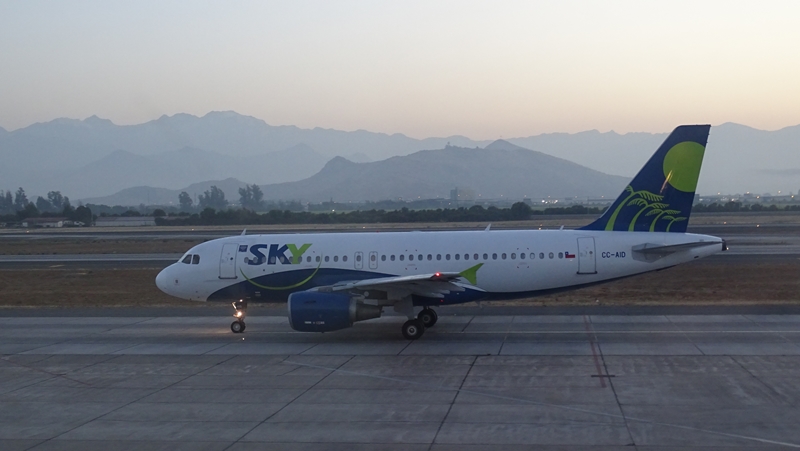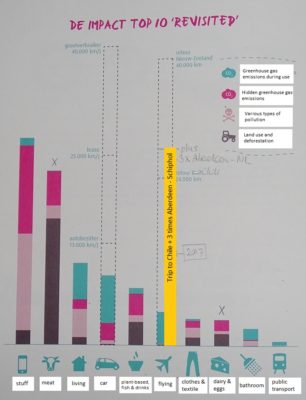I inhale deeply as I step into the plane. Kerosene and coffee, the friendly smile of the KLM stewardess; it already feels a bit like coming home. We sit down and I take my book out. It’s a Dutch book by Babette Porcelijn. The title translates as: The hidden impact — everything for an eco-positive life. We got it for Christmas. The central message of the book is summarized in the graph below. Babette has classified the things that we do or buy on a regular basis into ten categories. For each category, scientists have calculated how much impact the average Dutch person has on the natural environment, both directly and indirectly. This covers things like greenhouse gas emissions, environmental pollution and deforestation.

To my great satisfaction, I immediately notice that eating meat is the second biggest culprit, after buying stuff. With my vegan diet I eliminate all this negative impact, plus that of dairy and eggs. Ha, good. The fact that animal husbandry puts a heavy burden on the environment is not the reason that I am a vegan, but it is a nice bonus. I also buy virtually all my clothes in charity shops. While the aircraft roars over the runway, I continue browsing with enthusiasm. This book is the ideal Christmas present — it gives me a warm and fuzzy feeling.
Until I reach the chapter about transport.
The graph places the category flying at a modest sixth place. But, just like car use, the impact from this category is very scalable, and can easily get very high. In the book, Babette takes a trip to Bali as an example. Guiltily, I shuffle in my chair when I realize that this year we flew back and forth to Chile. After that, we made three trips from Aberdeen (where we currently live) to the Netherlands. Each time we decided to fly because we did not have the time and energy to spend four days in buses and trains.
All in all, I have almost completely undone the positive effect of my vegan diet through my air travel this year: see the yellow bar in the chart.
People are flying more and more, because it is getting cheaper. After meat, it is the cheapest way to pollute the environment (impact per euro). I think that this is still true if you compensate your CO2 emissions by planting trees. This Christmas, we did that for € 8 per person at Trees for All.
 Planting trees should not become a license to continue polluting. Most compensation trees are planted in developing countries. The people there, who contribute the least to greenhouse gas emissions, have to make way for our ‘debt forests’. When Staatsbosbeheer proposed to plant 100,000 hectares of forest in the Netherlands, there was a lot of protest from the agricultural sector.
Planting trees should not become a license to continue polluting. Most compensation trees are planted in developing countries. The people there, who contribute the least to greenhouse gas emissions, have to make way for our ‘debt forests’. When Staatsbosbeheer proposed to plant 100,000 hectares of forest in the Netherlands, there was a lot of protest from the agricultural sector.
Until now I always felt guiltier about trips within Europe than about our big trip to Chile. After all, there is always an alternative within Europe. Long distance travel seemed a kind of fixed fact in my life. It comes with the times: the world has become a village. But with this chart on my lap I realize that these flights have a huge impact on the well-being of our planet. From now on, I strongly intend to avoid long distance travel as much as possible.
 In the end it is not an exchange game, something like: some people eat meat every day but don’t fly; others are vegan but travel all over the world. Babette’s graph shows the current situation. If everyone on earth lived like that, we would need 4 planets. So in order to live within ecological limits (sustainably), the total impact must be reduced by ¾. The book provides practical tools to find the categories where you can reduce the most impact. You can also do this online.
In the end it is not an exchange game, something like: some people eat meat every day but don’t fly; others are vegan but travel all over the world. Babette’s graph shows the current situation. If everyone on earth lived like that, we would need 4 planets. So in order to live within ecological limits (sustainably), the total impact must be reduced by ¾. The book provides practical tools to find the categories where you can reduce the most impact. You can also do this online.
In any case, I have my found first point of improvement. If I come across any more, I will certainly share them on Ronde Maan. An eco-positive 2018, let’s do it!

